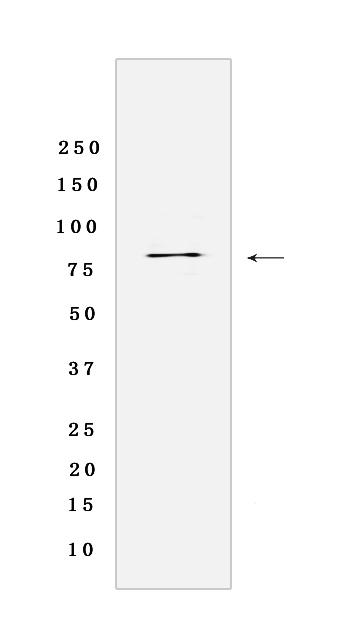Lactoferrin Rabbit mAb [X4C4]Cat NO.: A86101
Western blot analysis of extracts from PBMC cells lyastes.using Lactoferrin Rabbit mAb [X4C4] at dilution of 1:1000 incubated at 4℃ over night
Product information
Protein names :LTF,GIG12,LF,TRFL_HUMAN,Lactotransferrin [Cleaved into: Lactoferricin-H ,Kaliocin-1,Lactoferroxin-A,Lactoferroxin-B,Lactoferroxin-C]
UniProtID :P02788
MASS(da) :78,182
MW(kDa) :85 kDa
Form :Liquid
Purification :Protein A purification
Host :Rabbit
Isotype :IgG
sensitivity :Endogenous
Reactivity :Human
- ApplicationDilution
- 免疫印迹(WB)1:1000-2000
- 免疫荧光(ICC/IF)1:100,
- The optimal dilutions should be determined by the end user
Specificity :Antibody is produced by immunizing animals with a synthetic peptide of Human Lactoferrin.
Storage :Antibody store in 10 mM PBS, 0.5mg/ml BSA, 50% glycerol. Shipped at 4°C. Store at-20°C or -80°C. Products are valid for one natural year of receipt.Avoid repeated freeze / thaw cycles.
WB Positive detected :PBMC cells lyastes
Function : Transferrins are iron binding transport proteins which can bind two Fe(3+) ions in association with the binding of an anion, usually bicarbonate.., [Lactotransferrin]: Major iron-binding and multifunctional protein found in exocrine fluids such as breast milk and mucosal secretions (PubMed:14573629, PubMed:1599934, PubMed:6802759, PubMed:3169987, PubMed:11179314, PubMed:12693969). Has antimicrobial activity, which depends on the extracellular cation concentration (PubMed:6802759). Antimicrobial properties include bacteriostasis, which is related to its ability to sequester free iron and thus inhibit microbial growth, as well as direct bactericidal properties leading to the release of lipopolysaccharides from the bacterial outer membrane (PubMed:14573629, PubMed:1599934, PubMed:6802759, PubMed:3169987, PubMed:11179314, PubMed:12693969). Can also prevent bacterial biofilm development in P.aeruginosa infection (PubMed:12037568). Has weak antifungal activity against C.albicans (PubMed:11083624). Has anabolic, differentiating and anti-apoptotic effects on osteoblasts and can also inhibit osteoclastogenesis, possibly playing a role in the regulation of bone growth (PubMed:15166119). Promotes binding of species C adenoviruses to epithelial cells, promoting adenovirus infection (PubMed:17079302). Can inhibit papillomavirus infections (PubMed:17481742). Stimulates the TLR4 signaling pathway leading to NF-kappa-B activation and subsequent pro-inflammatory cytokine production while also interfering with the lipopolysaccharide (LPS)-stimulated TLR4 signaling (PubMed:20345905). Inhibits neutrophil granulocyte migration to sites of apoptosis, when secreted by apoptotic cells (PubMed:19033648). Stimulates VEGFA-mediated endothelial cell migration and proliferation (PubMed:16842782). Binds heparin, chondroitin sulfate and possibly other glycosaminoglycans (GAGs) (PubMed:9359845). Also binds specifically to pneumococcal surface protein A (PspA), the lipid A portion of bacterial lipopolysaccharide (LPS), lysozyme and DNA (PubMed:9359845).., Lactoferricin binds to the bacterial surface and is crucial for the bactericidal functions. Has some antiviral activity against papillomavirus infection (PubMed:17481742). N-terminal region shows strong antifungal activity against C.albicans (PubMed:11083624). Contains two BBXB heparin-binding consensus sequences that appear to form the predominate functional GAG-binding site.., [Kaliocin-1]: Has antimicrobial activity and is able to permeabilize different ions through liposomal membranes.., [Lactoferroxin-A]: Has opioid antagonist activity (PubMed:1369293). Shows preference for mu-receptor (PubMed:1369293).., [Lactoferroxin-B]: Has opioid antagonist activity (PubMed:1369293). Shows higher degrees of preference for kappa-receptors than for mu-receptors (PubMed:1369293).., [Lactoferroxin-C]: Has opioid antagonist activity (PubMed:1369293). Shows higher degrees of preference for kappa-receptors than for mu-receptors (PubMed:1369293).., The lactotransferrin transferrin-like domain 1 functions as a serine protease of the peptidase S60 family that cuts arginine rich regions (PubMed:12535064). This function contributes to the antimicrobial activity (PubMed:12535064). Shows a preferential cleavage at -Arg-Ser-Arg-Arg-|- and -Arg-Arg-Ser-Arg-|-, and of Z-Phe-Arg-|-aminomethylcoumarin sites (PubMed:12535064).., [Isoform DeltaLf]: Transcription factor with antiproliferative properties and ability to induce cell cycle arrest (PubMed:15222485). Binds to the DeltaLf response element found in the SKP1, BAX, DCPS, and SELENOH promoters (PubMed:22320386)..
Tissue specificity :High levels are found in saliva and tears, intermediate levels in serum and plasma, and low levels in urine. In kidney, detected in the distal collecting tubules in the medulla but not in the cortical region or in blood vessels. Detected in peripheral blood neutrophils (at protein level). Isoform 1 and isoform DeltaLf are expressed in breast, prostate, spleen, pancreas, kidney, small intestine, lung, skeletal muscle, uterus, thymus and fetal liver. Isoform 1 is expressed in brain, testis and peripheral blood leukocytes,isoform DeltaLf is barely detectable in these tissues. Isoform DeltaLf is expressed in placenta, liver and ovary,isoform 1 is barely detectable in these tissues. In kidney, isoform 1 is expressed at high levels in the collecting tubules of the medulla but at very low levels in the cortex..
Subcellular locationi :[Isoform 1]: Secreted. Cytoplasmic granule.
IMPORTANT: For western blots, incubate membrane with diluted primary antibody in 1% w/v BSA, 1X TBST at 4°C overnight.


